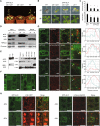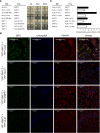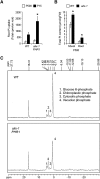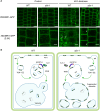ESCRT-III-Associated Protein ALIX Mediates High-Affinity Phosphate Transporter Trafficking to Maintain Phosphate Homeostasis in Arabidopsis
- PMID: 26342016
- PMCID: PMC4815105
- DOI: 10.1105/tpc.15.00393
ESCRT-III-Associated Protein ALIX Mediates High-Affinity Phosphate Transporter Trafficking to Maintain Phosphate Homeostasis in Arabidopsis
Erratum in
-
Correction to: ESCRT-III-Associated Protein ALIX Mediates High-Affinity Phosphate Transporter Trafficking to Maintain Phosphate Homeostasis in Arabidopsis.Plant Cell. 2022 Jul 4;34(7):2809. doi: 10.1093/plcell/koac103. Plant Cell. 2022. PMID: 35348792 Free PMC article. No abstract available.
Abstract
Prior to the release of their cargoes into the vacuolar lumen, sorting endosomes mature into multivesicular bodies (MVBs) through the action of ENDOSOMAL COMPLEX REQUIRED FOR TRANSPORT (ESCRT) protein complexes. MVB-mediated sorting of high-affinity phosphate transporters (PHT1) to the vacuole limits their plasma membrane levels under phosphate-sufficient conditions, a process that allows plants to maintain phosphate homeostasis. Here, we describe ALIX, a cytosolic protein that associates with MVB by interacting with ESCRT-III subunit SNF7 and mediates PHT1;1 trafficking to the vacuole in Arabidopsis thaliana. We show that the partial loss-of-function mutant alix-1 displays reduced vacuolar degradation of PHT1;1. ALIX derivatives containing the alix-1 mutation showed reduced interaction with SNF7, providing a simple molecular explanation for impaired cargo trafficking in alix-1 mutants. In fact, the alix-1 mutation also hampered vacuolar sorting of the brassinosteroid receptor BRI1. We also show that alix-1 displays altered vacuole morphogenesis, implying a new role for ALIX proteins in vacuolar biogenesis, likely acting as part of ESCRT-III complexes. In line with a presumed broad target spectrum, the alix-1 mutation is pleiotropic, leading to reduced plant growth and late flowering, with stronger alix mutations being lethal, indicating that ALIX participates in diverse processes in plants essential for their life.
© 2015 American Society of Plant Biologists. All rights reserved.
Figures










Similar articles
-
Plant ESCRT protein ALIX coordinates with retromer complex in regulating receptor-mediated sorting of soluble vacuolar proteins.Proc Natl Acad Sci U S A. 2022 May 17;119(20):e2200492119. doi: 10.1073/pnas.2200492119. Epub 2022 May 9. Proc Natl Acad Sci U S A. 2022. PMID: 35533279 Free PMC article.
-
Arabidopsis ALIX Regulates Stomatal Aperture and Turnover of Abscisic Acid Receptors.Plant Cell. 2019 Oct;31(10):2411-2429. doi: 10.1105/tpc.19.00399. Epub 2019 Jul 30. Plant Cell. 2019. PMID: 31363038 Free PMC article.
-
Arabidopsis ALIX is required for the endosomal localization of the deubiquitinating enzyme AMSH3.Proc Natl Acad Sci U S A. 2015 Oct 6;112(40):E5543-51. doi: 10.1073/pnas.1510516112. Epub 2015 Aug 31. Proc Natl Acad Sci U S A. 2015. PMID: 26324913 Free PMC article.
-
Endosomal functions in plants.Traffic. 2008 Sep;9(10):1589-98. doi: 10.1111/j.1600-0854.2008.00787.x. Epub 2008 Jul 9. Traffic. 2008. PMID: 18627577 Review.
-
ESCRTing in cereals: still a long way to go.Sci China Life Sci. 2019 Sep;62(9):1144-1152. doi: 10.1007/s11427-019-9572-9. Epub 2019 Jul 19. Sci China Life Sci. 2019. PMID: 31327097 Review.
Cited by
-
Regulation of Three Key Kinases of Brassinosteroid Signaling Pathway.Int J Mol Sci. 2020 Jun 18;21(12):4340. doi: 10.3390/ijms21124340. Int J Mol Sci. 2020. PMID: 32570783 Free PMC article. Review.
-
Plant ESCRT protein ALIX coordinates with retromer complex in regulating receptor-mediated sorting of soluble vacuolar proteins.Proc Natl Acad Sci U S A. 2022 May 17;119(20):e2200492119. doi: 10.1073/pnas.2200492119. Epub 2022 May 9. Proc Natl Acad Sci U S A. 2022. PMID: 35533279 Free PMC article.
-
The plant-unique protein DRIF1 coordinates with sorting nexin 1 to regulate membrane protein homeostasis.Plant Cell. 2023 Nov 30;35(12):4217-4237. doi: 10.1093/plcell/koad227. Plant Cell. 2023. PMID: 37647529 Free PMC article.
-
The green ESCRTs: Newly defined roles for ESCRT proteins in plants.J Biol Chem. 2025 May;301(5):108465. doi: 10.1016/j.jbc.2025.108465. Epub 2025 Mar 27. J Biol Chem. 2025. PMID: 40157538 Free PMC article. Review.
-
Cellular and Subcellular Phosphate Transport Machinery in Plants.Int J Mol Sci. 2018 Jun 29;19(7):1914. doi: 10.3390/ijms19071914. Int J Mol Sci. 2018. PMID: 29966288 Free PMC article. Review.
References
-
- Ames B.N. (1966). Assay of inorganic phosphate, total phosphate and phosphatases. Methods Enzymol. 8: 115–118.
-
- Aubert S., Alban C., Bligny R., Douce R. (1996). Induction of beta-methylcrotonyl-coenzyme A carboxylase in higher plant cells during carbohydrate starvation: evidence for a role of MCCase in leucine catabolism. FEBS Lett. 383: 175–180. - PubMed
-
- Babst M. (2005). A protein’s final ESCRT. Traffic 6: 2–9. - PubMed
-
- Babst M., Katzmann D.J., Estepa-Sabal E.J., Meerloo T., Emr S.D. (2002a). Escrt-III: an endosome-associated heterooligomeric protein complex required for mvb sorting. Dev. Cell 3: 271–282. - PubMed
Publication types
MeSH terms
Substances
LinkOut - more resources
Full Text Sources
Other Literature Sources
Molecular Biology Databases
Miscellaneous

